Frequency and phase measurement
An important electrical quantity with no
equivalent in DC circuits is frequency. Frequency
measurement is very important in many applications of
alternating current, especially in AC power systems designed
to run efficiently at one frequency and one frequency only.
If the AC is being generated by an electromechanical
alternator, the frequency will be directly proportional to
the shaft speed of the machine, and frequency could be
measured simply by measuring the speed of the shaft. If
frequency needs to be measured at some distance from the
alternator, though, other means of measurement will be
necessary.
One simple but crude method of frequency
measurement in power systems utilizes the principle of
mechanical resonance. Every physical object possessing the
property of elasticity (springiness) has an inherent
frequency at which it will prefer to vibrate. The tuning
fork is a great example of this: strike it once and it will
continue to vibrate at a tone specific to its length. Longer
tuning forks have lower resonant frequencies: their tones
will be lower on the musical scale than shorter forks.
Imagine a row of progressively-sized tuning
forks arranged side-by-side. They are all mounted on a
common base, and that base is vibrated at the frequency of
the measured AC voltage (or current) by means of an
electromagnet. Whichever tuning fork is closest in resonant
frequency to the frequency of that vibration will tend to
shake the most (or the loudest). If the forks' tines were
flimsy enough, we could see the relative motion of each by
the length of the blur we would see as we inspected each one
from an end-view perspective. Well, make a collection of
"tuning forks" out of a strip of sheet metal cut in a
pattern akin to a rake, and you have the vibrating reed
frequency meter:
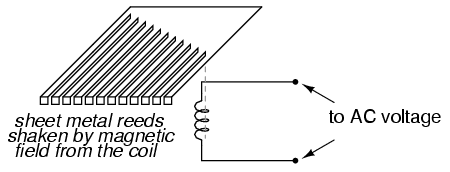
The user of this meter views the ends of all
those unequal length reeds as they are collectively shaken
at the frequency of the applied AC voltage to the coil. The
one closest in resonant frequency to the applied AC will
vibrate the most, looking something like this:
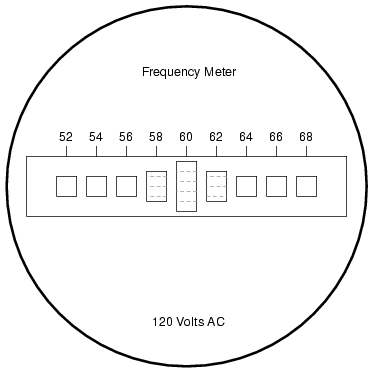
Vibrating reed meters, obviously, are not
precision instruments, but they are very simple and
therefore easy to manufacture to be rugged. They are often
found on small engine-driven generator sets for the purpose
of setting engine speed so that the frequency is somewhat
close to 60 (50 in Europe) Hertz.
While reed-type meters are imprecise, their
operational principle is not. In lieu of mechanical
resonance, we may substitute electrical resonance and design
a frequency meter using an inductor and capacitor in the
form of a tank circuit (parallel inductor and capacitor).
One or both components are made adjustable, and a meter is
placed in the circuit to indicate maximum amplitude of
voltage across the two components. The adjustment knob(s)
are calibrated to show resonant frequency for any given
setting, and the frequency is read from them after the
device has been adjusted for maximum indication on the
meter. Essentially, this is a tunable filter circuit which
is adjusted and then read in a manner similar to a bridge
circuit (which must be balanced for a "null" condition and
then read).
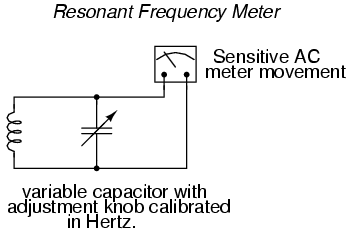
This technique is a popular one for amateur
radio operators (or at least it was before the advent of
inexpensive digital frequency instruments called counters),
especially because it doesn't require direct connection to
the circuit. So long as the inductor and/or capacitor can
intercept enough stray field (magnetic or electric,
respectively) from the circuit under test to cause the meter
to indicate, it will work.
In frequency as in other types of electrical
measurement, the most accurate means of measurement are
usually those where an unknown quantity is compared against
a known standard, the basic instrument doing nothing
more than indicating when the two quantities are equal to
each other. This is the basic principle behind the DC
(Wheatstone) bridge circuit and it is a sound metrological
principle applied throughout the sciences. If we have access
to an accurate frequency standard (a source of AC voltage
holding very precisely to a single frequency), then
measurement of any unknown frequency by comparison should be
relatively easy.
For that frequency standard, we turn our
attention back to the tuning fork, or at least a more modern
variation of it called the quartz crystal. Quartz is
a naturally occurring mineral possessing a very interesting
property called piezoelectricity. Piezoelectric
materials produce a voltage across their length when
physically stressed, and will physically deform when an
external voltage is applied across their lengths. This
deformation is very, very slight in most cases, but it does
exist.
Quartz rock is elastic (springy) within that
small range of bending which an external voltage would
produce, which means that it will have a mechanical resonant
frequency of its own capable of being manifested as an
electrical voltage signal. In other words, if a chip of
quartz is struck, it will "ring" with its own unique
frequency determined by the length of the chip, and that
resonant oscillation will produce an equivalent voltage
across multiple points of the quartz chip which can be
tapped into by wires fixed to the surface of the chip. In
reciprocal manner, the quartz chip will tend to vibrate most
when it is "excited" by an applied AC voltage at precisely
the right frequency, just like the reeds on a vibrating-reed
frequency meter.
Chips of quartz rock can be precisely cut
for desired resonant frequencies, and that chip mounted
securely inside a protective shell with wires extending for
connection to an external electric circuit. When packaged as
such, the resulting device is simply called a crystal
(or sometimes "xtal"), and its schematic symbol looks
like this:
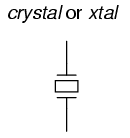
Electrically, that quartz chip is equivalent
to a series LC resonant circuit. The dielectric properties
of quartz contribute an additional capacitive element to the
equivalent circuit, and in the end it looks something like
this:
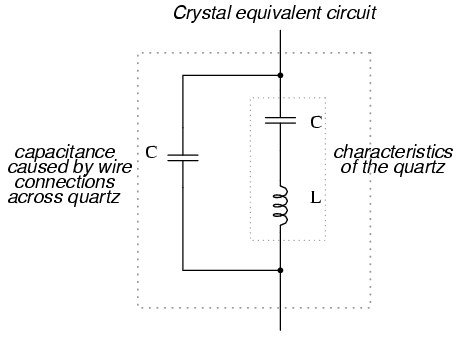
The "capacitance" and "inductance" shown in
series are merely electrical equivalents of the quartz's
mechanical resonance properties: they do not exist as
discrete components within the crystal. The capacitance
shown in parallel due to the wire connections across the
dielectric (insulating) quartz body is real, and it has an
effect on the resonant response of the whole system. A full
discussion on crystal dynamics is not necessary here, but
what needs to be understood about crystals is this resonant
circuit equivalence and how it can be exploited within an
oscillator circuit to achieve an output voltage with a
stable, known frequency.
Crystals, as resonant elements, typically
have much higher "Q" (quality) values than tank
circuits built from inductors and capacitors, principally
due to the relative absence of stray resistance, making
their resonant frequencies very definite and precise.
Because the resonant frequency is solely dependent on the
physical properties of quartz (a very stable substance,
mechanically), the resonant frequency variation over time
with a quartz crystal is very, very low. This is how
quartz movement watches obtain their high accuracy: by
means of an electronic oscillator stabilized by the resonant
action of a quartz crystal.
For laboratory applications, though, even
greater frequency stability may be desired. To achieve this,
the crystal in question may be placed in a temperature
stabilized environment (usually an oven), thus eliminating
frequency errors due to thermal expansion and contraction of
the quartz.
For the ultimate in a frequency standard
though, nothing discovered thus far surpasses the accuracy
of a single resonating atom. This is the principle of the
so-called atomic clock, which uses an atom of mercury
(or cesium) suspended in a vacuum, excited by outside energy
to resonate at its own unique frequency. The resulting
frequency is detected as a radio-wave signal and that forms
the basis for the most accurate clocks known to humanity.
National standards laboratories around the world maintain a
few of these hyper-accurate clocks, and broadcast frequency
signals based on those atoms' vibrations for scientists and
technicians to tune in and use for frequency calibration
purposes.
Now we get to the practical part: once we
have a source of accurate frequency, how do we
compare that against an unknown frequency to obtain a
measurement? One way is to use a CRT as a
frequency-comparison device. Cathode Ray Tubes typically
have means of deflecting the electron beam in the horizontal
as well as the vertical axis. If metal plates are used to
electrostatically deflect the electrons, there will be a
pair of plates to the left and right of the beam as well as
a pair of plates above and below the beam.
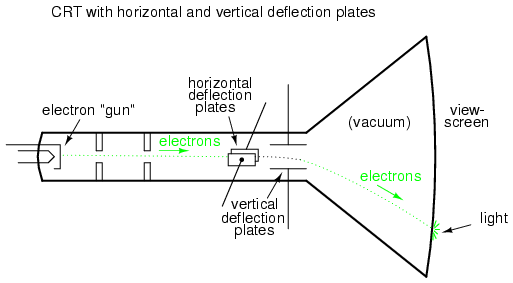
If we allow one AC signal to deflect the
beam up and down (connect that AC voltage source to the
"vertical" deflection plates) and another AC signal to
deflect the beam left and right (using the other pair of
deflection plates), patterns will be produced on the screen
of the CRT indicative of the ratio of these two AC
frequencies. These patterns are called Lissajous figures
and are a common means of comparative frequency measurement
in electronics.
If the two frequencies are the same, we will
obtain a simple figure on the screen of the CRT, the shape
of that figure being dependent upon the phase shift between
the two AC signals. Here is a sampling of Lissajous figures
for two sine-wave signals of equal frequency, shown as they
would appear on the face of an oscilloscope (an AC
voltage-measuring instrument using a CRT as its "movement").
The first picture is of the Lissajous figure formed by two
AC voltages perfectly in phase with each other:
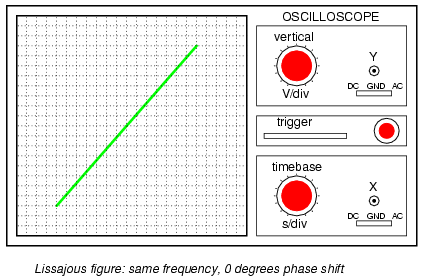
If the two AC voltages are not in phase with
each other, a straight line will not be formed. Rather, the
Lissajous figure will take on the appearance of an oval,
becoming perfectly circular if the phase shift is exactly 90o
between the two signals, and if their amplitudes are equal:
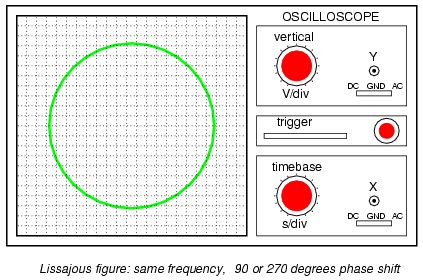
Finally, if the two AC signals are directly
opposing one another in phase (180o shift), we
will end up with a line again, only this time it will be
oriented in the opposite direction:
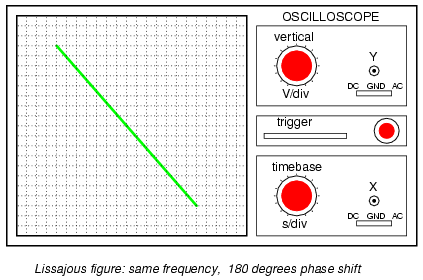
When we are faced with signal frequencies
that are not the same, Lissajous figures get quite a bit
more complex. Consider the following examples and their
given vertical/horizontal frequency ratios:
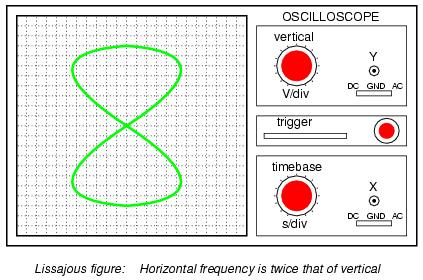
The more complex the ratio between
horizontal and vertical frequencies, the more complex the
Lissajous figure. Consider the following illustration of a
3:1 frequency ratio between horizontal and vertical:
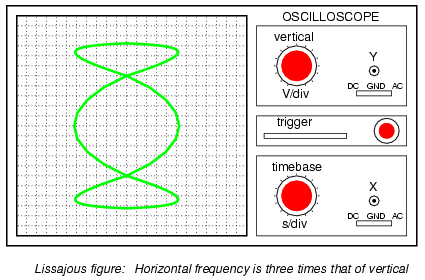
. . . and a 3:2 frequency ratio (horizontal
= 3, vertical = 2):
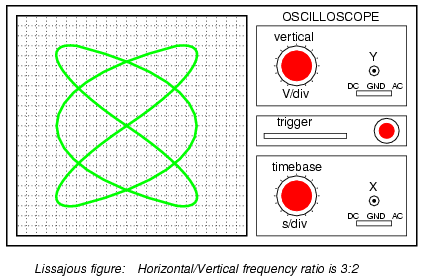
In cases where the frequencies of the two AC
signals are not exactly a simple ratio of each other (but
close), the Lissajous figure will appear to "move," slowly
changing orientation as the phase angle between the two
waveforms rolls between 0o and 180o.
If the two frequencies are locked in an exact integer ratio
between each other, the Lissajous figure will be stable on
the viewscreen of the CRT.
The physics of Lissajous figures limits
their usefulness as a frequency-comparison technique to
cases where the frequency ratios are simple integer values
(1:1, 1:2, 1:3, 2:3, 3:4, etc.). Despite this limitation,
Lissajous figures are a popular means of frequency
comparison wherever an accessible frequency standard (signal
generator) exists.
-
REVIEW:
-
Some frequency meters work on the
principle of mechanical resonance, indicating frequency by
relative oscillation among a set of uniquely tuned "reeds"
shaken at the measured frequency.
-
Other frequency meters use electric
resonant circuits (LC tank circuits, usually) to indicate
frequency. One or both components is made to be
adjustable, with an accurately calibrated adjustment knob,
and a sensitive meter is read for maximum voltage or
current at the point of resonance.
-
Frequency can be measured in a comparative
fashion, as is the case when using a CRT to generate
Lissajous figures. Reference frequency signals can be
made with a high degree of accuracy by oscillator circuits
using quartz crystals as resonant devices. For ultra
precision, atomic clock signal standards (based on the
resonant frequencies of individual atoms) can be used.
|